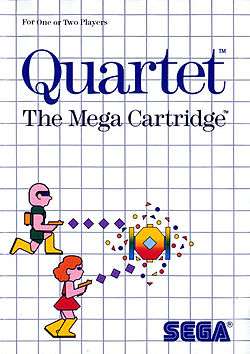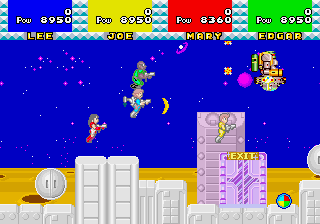Quartet (video game)
| Quartet | |
|---|---|
 Quartet Master System US & European Box Art | |
| Developer(s) |
Sega (Arcade and SMS), Probe Software (other versions) |
| Publisher(s) |
Sega (Arcade and SMS), Activision (other versions) |
| Designer(s) | Rieko Kodama |
| Composer(s) | Katsuhiro Hayashi |
| Platform(s) | Arcade, Sega Master System, Amstrad CPC, Commodore 64, ZX Spectrum |
| Release date(s) | April 1986[1] |
| Genre(s) | 2D action platformer |
| Mode(s) |
Up to four players simultaneously (arcade) two players simultaneously (other versions) |
| Arcade system | Sega System 16 |
Quartet is a 1986 arcade game by Sega. Quartet allows one to four players to guide a set of characters through a base taken over by an army of robots. Players control either Joe (yellow), Mary (red), Lee (blue) or Edgar (green) across a number of sideways-scrolling levels. The object of the game is to advance through the level, fighting opponents that come out of portals in the walls, and eventually defeat a boss that carries the door key used to open the "exit door" for the level.
Overview

Players can find various power-ups during play, such as a jet pack that allowed characters to stay airborne, springs to jump higher, speed boots, and point bonuses. Each character has a separate characteristic weapon type, which can be upgraded by picking up a coloured bouncing orb that bounced across the screen occasionally. Picking up the orb when it is a player's colour gives a weapon power up, while picking up the orb when it is another player's color gives a point bonus (but deprives the other player the chance to upgrade).
Available in arcades in the same timeframe as Gauntlet, Quartet provided another option for more than two players.
The game was ported to the Sega Master System. However, only Mary and Edgar (whose name is spelled "Edger" and given a lighter skin tone) were playable, with the title confusingly referring to a four-person band that doesn't exist in the game. Because of this, in Japan the game was retitled Double Target. Mary's character design was also altered between regional versions. In the Japanese version Mary had more Asian-like features (including black hair), whereas in the western versions she has Caucasian features instead (which resembles Sigourney Weaver's character Ellen Ripley from the movie Aliens).
The game was also ported to home computers Commodore 64, Amstrad CPC and Sinclair ZX Spectrum.
The tunes "Oki Rap" and "FM Funk" were later recycled for 1991's Spider-Man: The Video Game.
Quartet was mentioned in episode 62 of The Biggest Problem in the Universe, in the part where Maddox described his first cartoon crush which was Mary from the game.
Updates
Quartet 2 is an updated version of Quartet, which was only released as a conversion kit. While both games was released in the same year, the differences are a two-player mode instead of four, and the option to select characters. In addition, new level designs were loaded into Quartet 2, giving the game 32 distinct levels, compared to 16 for the original Quartet (recycling of levels starts on 33 for Quartet 2, 17 for Quartet).
References
External links
- Quartet at the Killer List of Videogames
- Quartet at World of Spectrum
- Quartet description at arcade-history.com